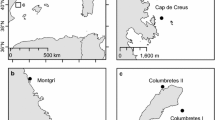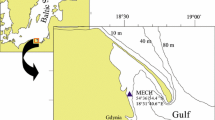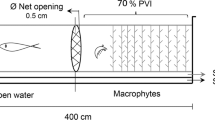Abstract
An experiment was carried out investigating the colonization ability and specific pattern of copepods towards a provisional benthic habitat. Since copepods are known to disperse passively and actively, the experiment aimed to investigate the pool of colonizers of macrophytodetritus and the species-specific active colonization pathways. The experiment was performed in a Mediterranean seagrass Posidonia oceanica meadow on defaunated macrophytodetritus accumulations (mainly dead seagrass leaves) for two time intervals (24 and 96 h). Active colonization by copepods, independently of their adjacent potential source pool habitat (bare sandy sediments, P. oceanica canopy, water column and macrophytodetritus) occurred within 24 h. Natural densities (as in the control treatments) were only reached by active colonization through the water column. Both neither diversities nor species composition of natural macrophytodetritus were ever reached by one single migratory pathway, therefore only a combination of interstitial migration and water column migration can explain the species occurrence under natural condition. Moreover, every potential adjacent source pool habitat contributed species to the newly colonized macrophytodetritus. However, the main colonizers were mostly species with good swimming capabilities. The diverse pool of species present in the newly colonized macrophytodetritus underlines the complex communities and dispersion capabilities of copepods. Hence, macrophytodetritus possesses the potential ability to be a colonizer source pool for every adjacent habitat and thus behaves as a copepod hub for the entire seagrass ecosystem.



Similar content being viewed by others
References
Anderson MJ, Gorley RN, Clarke KR (2008) PERMANOVA+ for PRIMER: guide to software and statistical methods. PRIMER-E, Plymouth
Armonies W (1994) Drifting meio- and macrobenthic invertebrates on tidal flats in Königshafen: a review. Helgolander Meeresunters 48:299–320. doi:10.1007/BF02367043
Bell SS, Walters K, Hall MO (1987) Habitat utilization by harpacticoid copepods—a morphometric approach. Mar Ecol Prog Ser 35:59–64. doi:10.3354/meps035059
Bodin P, Leguellec C (1992) Meiobenthos of the bay of Saint-Brieuc (North Brittany, France). 2. Harpacticoid copepod diversity and species assemblages. Oceanol Acta 15:673–686
Bongers T (1990) The maturity index: an ecological measure of environmental disturbance based on nematode species composition. Oecologia 83:14–19. doi:10.1007/bf00324627
Bonsdorff E (1992) Drifting algae and zoobenthos—effects on settling and community structure. Neth J Sea Res 30:57–62. doi:10.1016/0077-7579(92)90045-g
Bostrom C, Bonsdorff E (2000) Zoobenthic community establishment and habitat complexity—the importance of seagrass shoot-density, morphology and physical disturbance for faunal recruitment. Mar Ecol Prog Ser 205:123–138
Bostrom C, Tornroos A, Bonsdorff E (2010) Invertebrate dispersal and habitat heterogeneity: expression of biological traits in a seagrass landscape. J Exp Mar Biol Ecol 390:106–117. doi:10.1016/j.jembe.2010.05.008
Boxshall GA, Hasley SH (2004) An introduction to copepods diversity. The Ray Society, London
Cadotte MW (2007) Competition-colonization trade-offs and disturbance effects at multiple scales. Ecology 88:823–829. doi:10.1890/06-1117
Callens M, Gheerardyn H, Ndaro SGM, De Troch M, Vanreusel A (2012) Harpacticoid copepod colonization of coral fragments in a tropical reef lagoon (Zanzibar, Tanzania). J Mar Biol Assoc U K 92:1535–1545. doi:10.1017/s0025315411001597
Chandler GT, Fleeger JW (1983) Meiofaunal colonization of azoic estuarine sediment in Louisiana: mechanisms of dispersal. J Exp Mar Biol Ecol 69:175–188. doi:10.1016/0022-0981(83)90066-7
Chertoprud ES, Azovsky AI, Sapozhnikov FV (2005) Colonization of azoic sediments of different grain-size composition by littoral Harpacticoida : Copepoda. Oceanology 45:698–706
Clarke KR, Gorley RN (2006) PRIMER v6. In: PRIMER-E (ed) User Manual/Tutorial, Plymouth
Commito JA, Tita G (2002) Differential dispersal rates in an intertidal meiofauna assemblage. J Exp Mar Biol Ecol 268:237–256. doi:10.1016/S0022-0981(01)00386-0
Connell JH (1978) Diversity in tropical rain forests and coral reefs. Science 199:1302–1310. doi:10.1126/science.199.4335.1302
Coull BC, Wells JBJ (1983) Refuges from fish predation—experiments with phytal meiofauna from the New-Zealand rocky intertidals. Ecology 64:1599–1609. doi:10.2307/1937513
Danovaro R, Fraschetti S (2002) Meiofaunal vertical zonation on hard-bottoms: comparison with soft-bottom meiofauna. Mar Ecol Prog Ser 230:159–169. doi:10.3354/meps230159
Dauby P (1980) Cycle annuel du zooplancton de surface de la baie de Calvi (Corse). Biomasse totale et plancton copépodien. Acta Oecol 3:403–407
De Troch M, Gurdebeke S, Fiers F, Vincx M (2001) Zonation and structuring factors of meiofauna communities in a tropical seagrass bed (Gazi Bay, Kenya). J Sea Res 45:45–61. doi:10.1016/S1385-1101(00)00055-1
De Troch M, Vandepitte L, Raes M, Suarez-Morales E, Vincx M (2005) A field colonization experiment with meiofauna and seagrass mimics: effect of time, distance and leaf surface area. Mar Biol 148:73–86. doi:10.1007/s00227-005-0062-x
Decho AW, Fleeger JW (1988) Microscale dispersion of meiobenthic copepods in response to food-resource patchiness. J Exp Mar Biol Ecol 118:229–243. doi:10.1016/0022-0981(88)90075-5
Dethier MN, Brown AS, Burgess S, Eisenlord ME, Galloway AWE, Kimber J, Lowe AT, O’Neil CM, Raymond WW, Sosik EA, Duggins DO (2014) Degrading detritus: changes in food quality of aging kelp tissue varies with species. J Exp Mar Biol Ecol 460:72–79. doi:10.1016/j.jembe.2014.06.010
Faust MA, Gulledge RA (1996) Associations of microalgae and meiofauna in floating detritus at a mangrove island, Twin Cays, Belize. J Exp Mar Biol Ecol 197:159–175
Fleeger JW, Chandler GT, Fitzhugh GR, Phillips FE (1984) Effects of tidal currents on meiofauna densities in vegetated salt marsh sediments. Mar Ecol Prog Ser 19:49–53. doi:10.3354/meps019049
Fleeger JW, Yund PO, Sun B (1995) Active and passive processes associated with initial settlement and post-settlement dispersal of suspended meiobenthic copepod. J Mar Res 53:609–645. doi:10.1357/0022240953213070
Frisch D, Green AJ (2007) Copepods come in first: rapid colonization of new temporary ponds. Fundam Appl Limnol 168:289–297. doi:10.1127/1863-9135/2007/0168-0289
Gallmetzer I, Pflugfelder B, Zekely J, Ott JA (2005) Macrofauna diversity in Posidonia oceanica detritus: distribution and diversity of mobile macrofauna in shallow sublittoral accumulations of Posidonia oceanica detritus. Mar Biol 147:517–523. doi:10.1007/s00227-005-1594-9
Gheerardyn H, de Troch M, Vincx M, Vanreusel A (2009) Harpacticoida (Crustacea: Copepoda) associated with cold-water coral substrates in the Porcupine Seabight (NE Atlantic): species composition, diversity and reflections on the origin of the fauna. Sci Mar 73:747–760. doi:10.3989/scimar.2009.73n4747
Giere O (2009) Meiobenthology—the microscopic motile fauna of aquatic sediments. Springer, Berlin
Guidi-Guilvard LD, Thistle D, Khripounoff A, Gasparini S (2009) Dynamics of benthic copepods and other meiofauna in the benthic boundary layer of the deep NW Mediterranean Sea. Mar Ecol Prog Ser 396:181–195. doi:10.3354/meps08408
Hagerman GM, Rieger RM (1981) Dispersal of benthic meiofauna by wave and current action in bogue sound, North Carolina, USA. Mar Ecol 2:245–270. doi:10.1111/j.1439-0485.1981.tb00099.x
Hamner WM, Carleton JH (1979) Copepod swarms: attributes and role in coral reef ecosystems. Limnol Oceanogr 24:1–14
Heip C, Willems K, Van hauwermeiren G (1983) Een systematisch-ecologische studie van Copepoda Harpacticoida levend op bruinwieren van het genus Cystoseira in de Baai van Calvi (Corsica). LUC, Diepenbeek
Hicks GRF (1977) Observations on substrate preference of marine phytal harpacticoids (copepoda). Hydrobiologia 56:7–9
Hicks GRF (1980) Structure of phytal harpacticoid copepod assemblages and the influence of habitat complexity and turbidity. J Exp Mar Biol Ecol 44:157–192
Hicks GRF (1986) Distribution and behaviour of meiofaunal copepods inside and outside seagrass beds. Mar Ecol Prog Ser 31:159–170. doi:10.3354/meps031159
Hicks GRF, Coull BC (1983) The ecology of marine meiobenthic harpacticoid copepods. Oceanogr Mar Biol 21:67–175
Higgins R, Thiel H (1988) Introduction to the study of meiofauna. Smithsonian Institution Press, London
Hockin DC, Ollason JG (1981) The colonization of artificially isolated volumes of intertidal estuarine sand by harpacticoid copepods. J Exp Mar Biol Ecol 53:9–29. doi:10.1016/0022-0981(81)90081-2
Hulings NC, Gray JS (1971) A manual for the study of meiofauna. Smithson Contrib Zool 78:1–83
Huys R, Boxshall GA (1991) Copepod evolution. London Ray Society, London
Jacobi CM, Langevin R (1996) Habitat geometry of benthic substrata: effects on arrival and settlement of mobile epifauna. J Exp Mar Biol Ecol 206:39–54. doi:10.1016/s0022-0981(96)02605-6
Kiorboe T (2000) Colonization of marine snow aggregates by invertebrate zooplankton: abundance, scaling, and possible role. Limnol Oceanogr 45:479–484
Koski M, Kiorboe T, Takahashi K (2005) Benthic life in the pelagic: aggregate encounter and degradation rates by pelagic harpacticoid copepods. Limnol Oceanogr 50:1254–1263
Kotwicki L, De Troch M, Urban-Malinga B, Gheskiere T, Weslawski JM (2005) Horizontal and vertical distribution of meiofauna on sandy beaches of the North Sea (The Netherlands, Belgium, France). Helgol Mar Res 59:255–264. doi:10.1007/s10152-005-0001-8
Kurdziel JP, Bell SS (1992) Emergence and dispersal of phytal-dwelling meiobenthic copepods. J Exp Mar Biol Ecol 163:43–64. doi:10.1016/0022-0981(92)90146-2
Lang K (1948) Monographie der Harpacticiden. Hâkan Ohlssons boktryckeri, Lund
Lepoint G, Cox AS, Dauby P, Poulicek M, Gobert S (2006) Food sources of two detritivore amphipods associated with the seagrass Posidonia oceanica leaf litter. Mar Biol Res 2:355–365. doi:10.1080/17451000600962797
Magurran AE (2004) Measuring biological diversity. Blackwell Publishing, Oxford
Magurran AE, McGill BJ (2011) Biological diversity: frontiers in measurement and assessment. Oxford University Press, New York
Mascart T, Lepoint G, De Troch M (2013) Meiofauna and harpacticoid copepods in different habitats of a Mediterranean seagrass meadow. J Mar Biol Assoc UK 93:1557–1566. doi:10.1017/s0025315413000222
Mascart T, Lepoint G, Deschoemaeker S, Binard M, Remy F, De Troch M (2015) Seasonal variability of meiofauna, especially harpacticoid copepods, in Posidonia oceanica macrophytodetritus accumulations. J Sea Res 95:149–160. doi:10.1016/j.seares.2014.07.009
Mateo MA, Romero J (1997) Detritus dynamics in the seagrass Posidonia oceanica: elements for an ecosystem carbon and nutrient budget. Mar Ecol Prog Ser 151:43–53. doi:10.3354/meps151043
McIntyre AD (1969) Ecology of marine meiobenthos. Biol Rev 44:245–288. doi:10.1111/j.1469-185X.1969.tb00828.x
Noodt W (1971) Ecology of the Copepoda. Smithsonian Institution Press, Washington
Norkko A, Bonsdorff E (1996) Rapid zoobenthic community responses to accumulations of drifting algae. Mar Ecol Prog Ser 131:143–157. doi:10.3354/meps131143
Ólafsson E, Ingólfsson A, Steinarsdóttir MB (2001) Harpacticoid copepod communities of floating seaweed: controlling factors and implications for dispersal. Hydrobiologia 453–454:189–200
Palmer MA (1984) Invertebrate drift: behavioral experiments with intertidal meiobenthos. Mar Behav Physiol 10:235–253
Palmer MA (1988) Dispersal of marine meiofauna a review and conceptual model explaining passive transport and active emergence with implications for recruitment. Mar Ecol Prog Ser 48:81–91. doi:10.3354/meps048081
Palmer MA, Gust G (1985) Dispersal of meiofauna in a turbulent tidal creek. J Mar Res 43:179–210
Quinn GGP, Keough MJ (2002) Experimental design and data analysis for biologists. Cambridge University Press, Cambridge
Remane A (1952) Die Besiedlung des Sandbodens im Meere und die Bedeutung der Lebensformtypen für die Ökologie. Verhandlungen der Deutschen Zoologischen Gesellschaft 1951:327–359
Romero J, Pergent G, Pergentmartini C, Mateo MA, Regnier C (1992) The detritic compartment in a Posidonia oceanica meadow—litter features, decomposition rates and mineral stocks. Mar Ecol 13:69–83
Sanmarti N, Menendez M (2007) Litter decomposition of Scirpus maritimus L. in a Mediterranean coastal marsh: importance of the meiofauna during the initial phases of detached leaves decomposition. Int Rev Hydrobiol 92:211–226. doi:10.1002/iroh.200510955
Scheef LP, Marcus NH (2010) Occurrence and significance of copepod resting egg accumulation in seagrass sediments. Mar Ecol Prog Ser 407:125–134. doi:10.3354/meps08573
Sedlacek L, Thistle D (2006) Emergence on the continental shelf: differences among species and between microhabitats. Mar Ecol Prog Ser 311:29–36. doi:10.3354/meps311029
Sun B, Fleeger JW (1994) Field experiments on the colonization of meiofauna into sediment depressions. Mar Ecol Prog Ser 110:167–175. doi:10.3354/meps110167
Teasdale M, Vopel K, Thistle D (2004) The timing of benthic copepod emergence. Limnol Oceanogr 49:884–889
Thielemans LKH, Heip C (1984) The response of a harpacticoid copepod community to sediment disturbance in a semi-enclosed lagoon. Hydrobiologia 118:127–133. doi:10.1007/bf00031795
Thistle D (1978) Harpacticoid dispersion patterns implications for deep-sea diversity maintenance. J Mar Res 36:377–397
Thistle D, Sedlacek L (2004) Emergent and non-emergent species of harpacticoid copepods can be recognized morphologically. Mar Ecol Prog Ser 266:195–200. doi:10.3354/meps266195
Thistle D, Weatherly GL, Wonnacott A, Ertman SC (1995) Suspension by winter storms has an energetic cost for adult male benthic harpacticoid copepods at a shelf site. Mar Ecol Prog Ser 125:77–86. doi:10.3354/meps125077
Thomsen MS, Muth MF, McGlathery KJ (2011) Tube-forming polychaetes enhance invertebrate diversity and abundance in sandy sediments of Mozambique, Africa. Afr J Mar Sci 33:327–332. doi:10.2989/1814232x.2011.600433
Torres-Pratts H, Schizas NV (2007) Meiofaunal colonization of decaying leaves of the red mangrove Rhizophora mangle, in southwestern Puerto Rico. Caribb J Sci 43:127–137
Vetter EW (1995) Detritus-based patches of high secondary production in the nearshore benthos. Mar Ecol Prog Ser 120:251–262. doi:10.3354/meps120251
Walters K (1991) Influences of abundance, behavior, species composition, and ontogenetic stage on active emergence of meiobenthic copepods in subtropical habitats. Mar Biol 108:207–215. doi:10.1007/BF01344335
Walters K, Bell SS (1986) Diel patterns of active vertical migration in seagrass meiofauna. Mar Ecol Prog Ser 34:95–103. doi:10.3354/meps034095
Acknowledgments
The authors kindly thank the Stareso field station staff for their assistance in the experimental setup and Renzo Biondo for his help throughout the design. The authors thank the three anonymous referees for their constructive remarks that contributed to the improvement of the manuscript. The first author acknowledges a F.R.I.A. Ph.D. Grant (Belgian National Fund for Research Training in industry and in agriculture). This study was conducted within the frame of FRS-FNRS research Project FRFC 2.4511.09 (University of Liège) with additional support provided by the Ghent University (BOF-GOA 01GZ0705 and 01GA1911W). G. Lepoint is a Research Associate of the FRS-FNRS. M. De Troch is a postdoctoral fellow financed by the Special Research Fund of the Ghent University (BOF-GOA 01GA1911 W). This is the MARE paper number 288.
Author information
Authors and Affiliations
Corresponding author
Additional information
Communicated by M. Huettel.
Rights and permissions
About this article
Cite this article
Mascart, T., Agusto, L., Lepoint, G. et al. How do harpacticoid copepods colonize detrital seagrass leaves?. Mar Biol 162, 929–943 (2015). https://doi.org/10.1007/s00227-015-2632-x
Received:
Accepted:
Published:
Issue Date:
DOI: https://doi.org/10.1007/s00227-015-2632-x




